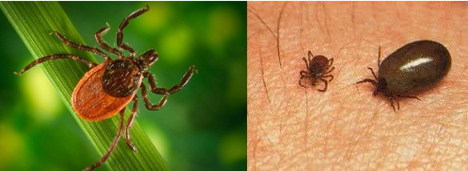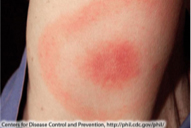
Our office offers comprehensive testing and natural treatment for Lyme and other tick-borne diseases (TBD). Dr. Goodman is a member of ILADS, the leading advocate for people suffering from persistent Lyme and other tick-borne diseases.
What is Lyme Disease?
Lyme Disease is caused by a bite from a tick carrying the spirochetal bacterium Borrelia burgdorferei. Spirochetes are spiral-shaped bacteria and include syphilis. Lyme disease has many symptoms, having been called “the great imitator” for its similarity in presentation to many other conditions.

The “classic” sign of Lyme Disease is the bullseye rash, or Erythema Migrans (EM). This rash can appear around the site of a tick bite, from 3-30 days after the bite, and occurs in 70-80% of people bitten by deer, or blacklegged, ticks.
Other Early Stage Symptoms
- Fever
- Chills
- Headache
- Fatigue
- Muscle and Joint Aches
- Swollen Lymph Nodes
If left untreated, the Borrelia spirochete will proliferate and take root in the joints, nervous system, and other parts of the body, leading to worsening symptoms.
Later Stage Symptoms (days to months after a tick bite)
- Severe headaches and stiff neck
- Additional EM rashes on other areas of the body
- Arthritis with severe joint pain and swelling, particularly the knees and other large joints.
- Facial palsy (loss of muscle tone or droop on one or both sides of the face)
- Intermittent pain in tendons, muscles, joints, and bones
- Heart palpitations or an irregular heart beat (Lyme carditis)
- Episodes of dizziness or shortness of breath
- Inflammation of the brain and spinal cord
- Nerve pain
- Shooting pains, numbness, or tingling in the hands or feet
- Problems with short-term memory
How is Lyme Disease Treated?
If caught early, Lyme can be effectively treated with antibiotics. Doxycycline is recommended for ages 8 and older, as it can permanently stain developing teeth. Conventional guidelines call for a single dose of 200 mg if a tick bite is found, to 100 mg twice a day for three weeks in cases with EM rash or positive lab tests.
We agree with the ILADS recommendation of a more aggressive course of treatment , with the underlying focus on eradicating the bacteria and preventing potentially devastating advanced cases of Lyme disease. ILADS also supports treatment of chronic manifestations of Lyme disease with aggressive antibiotic and other therapies.
In our office we use a combination of powerful, proven herbal formulas, vitamins and minerals, acupuncture and energetic medicines to kill the bacteria and help the body heal.

What are Tick-Borne Diseases?
Ticks pick up diseases from the animals which they feed upon and can transmit these to humans when they feed on us. Here in the northeast, three major types of tick are present: deer or black-legged ticks (Ixodes scapularis), Dog ticks (Dermacentor variabilis) and, increasingly, Lone Star Ticks (Amblyoma americanum).
If you get a tick bite, you may not end up with Lyme disease, but could have one of several other infections. Here are those most commonly seen in Connecticut (from the CDC):
- Anaplasmosis is transmitted to humans by tick bites primarily from the blacklegged tick (Ixodes scapularis) in the northeastern and upper midwestern U.S.
- Babesiosis is caused by microscopic parasites that infect red blood cells. Most human cases of babesiosis in the U.S. are caused by Babesia microti. Babesia microti is transmitted by the blacklegged tick (Ixodes scapularis) and is found primarily in the northeast and upper midwest.
- Ehrlichiosis is transmitted to humans by the lone star tick (Ambylomma americanum), found primarily in the southcentral and eastern U.S
- Powassan disease is transmitted by the blacklegged tick (Ixodes scapularis) and the groundhog tick (Ixodes cookei). Cases have been reported primarily from northeastern states and the Great Lakes region.
- Rocky Mountain spotted fever (RMSF) is transmitted by the American dog tick (Dermacentor variabilis) in the northeast.
- STARI (Southern tick-associated rash illness) is transmitted via bites from the lone star tick (Ambylomma americanum), found in the southeastern and eastern U.S.
- Tularemia is transmitted to humans by the dog tick (Dermacentor variabilis), the wood tick (Dermacentor andersoni), and the lone star tick (Amblyomma americanum). Tularemia occurs throughout the U.S.
- Bartonella is typically thought to be transmitted by a cat bite or scratch. Since ticks transmit bartonella to cats and since bartonella has been found in the spinal fluid of humans with lyme disease, many suspect direct transmission to humans.
This is a long list, with overlapping symptoms. We can test using conventional and specialty labs to identify/rule out infection with pathogens other than Lyme.
Common Questions Asked and Answered

- Can I take natural treatments while taking antibiotics? Yes. Most natural treatments are safe to take in conjunction with antibiotics, and many can act synergistically, enhancing the antibiotics’ effects.
- How long do natural treatments take to work? This depends on many factors: how aggressive the infection, how many co-infections one may have, how long one has had the infection, and how strong is one’s immune system and overall health. Many feel better within days, other take months to see a significant difference.
- Are there any side-effects from natural treatments? Yes. Depending on the medicine, one may experience any of a number of side-effects, including a Jarish-Herxheimer reaction (“herxing”), caused by release of bacterial toxins during die-off. Some patients may not experience any side-effects at all. We can effectively treat most side-effects with natural medicines, including herbs, minerals and vitamins.
- Does my insurance cover these treatments? Check the list of insurances for which Dr. Goodman is in-network. Retired State of CT employees on Medicare with Anthem BCBS as a secondary insurance are also covered. Medicines are not covered by insurance but HSA plans may allow payment from health savings. Check with your plan.
- How do I make an appointment? Contact the office at 860-584-5746 or email us at [email protected]
- If you suspect you have Lyme or another Tick-borne illness, you may complete the Horowitz MSIDS Questionnaire and self-score. If you seek to become a patient, please email or fax this with your intake information. You will need to download and open it in Adobe Reader in order to fill it out. If you don’t have Reader, just print and fill out by hand. You can then scan and email, fax or bring with you to your appointment.